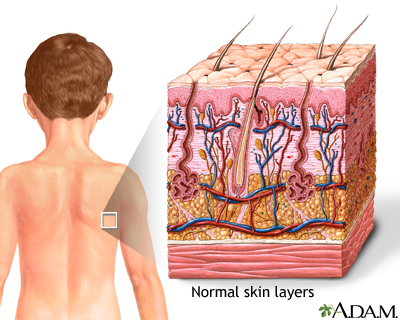The Journal of Physiology. Some autoimmune and immunological diseases target the desmosomes and hemidesmosomes founds in the epidermis. The dermis is the middle layer of the skin. UV-irradiation of human skin cells generates damages in DNA through direct photochemical reactions at adjacent thymine or cytosine residues on the same strand of DNA. The skin is the largest organ of the body. Small circular wounds are likely to shrink, not gape". Comment on this article. The most pronounced feature is the J-curve stress strain response, in which a region of large strain and minimal stress exists and corresponds to the microstructural straightening and reorientation of collagen fibrils. Nanoparticles of different materials have shown skin's permeability limitations. American Nurse. All users are urged to always seek advice from a registered health care professional for diagnosis and answers to their medical questions and to ascertain whether the particular therapy, service, product or treatment described on the website is suitable in their circumstances. The dermis contains sweat glands, sebaceous glands, hair follicles, blood vessels and nerves. Melanomas are cancers of the melanocytes and have a high metastatic potential, significantly mediated by the depth of the lesion.


Stratum corneum, cell layers, is the uppermost layer, made up of keratin and horny scales made up of dead keratinocytes, known as anucleate squamous cells. Surgical incisions made along these lines, less scarring will occur. Nanomedical researchers seek to target the epidermis and other layers of active cell division where nanoparticles can interact directly with cells that have lost their growth-control mechanisms cancer cells. It also contains the hair follicles , sweat glands , sebaceous glands , apocrine glands , lymphatic vessels and blood vessels. Gordon; et al. One application of transcutaneous particle delivery could be to locate and treat cancer. Retrieved 28 September Arrector pili muscle.
Actions for this page
This causes the epidermal layer to form a pit like opening on the surface of the duct in which the inner fluid will be secreted in an upwards fashion. Intercalary cells react identically to those of granular glands but on a smaller scale. Further information: senescence. The exocrine functions of the skin are by way of the sweat and sebaceous glands. Microorganisms like Staphylococcus epidermis colonize the skin surface. The Fitzpatrick scale [26] [27] is a numerical classification schema for human skin colour developed in as a way to classify the typical response of different types of skin to ultraviolet UV light:. For other mammals, see Skin. The epidermis and dermis are separated by a thin sheet of fibers called the basement membrane , which is made through the action of both tissues. NCBI Bookshelf. Also located within the reticular region are the roots of the hairs , sebaceous glands , sweat glands , receptors , nails , and blood vessels. This disease is associated with a positive nikolsky sign, peeling away from the epidermis with rubbing of that area. A skin cell usually ranges from 25 to 40 μm 2 , depending on a variety of factors.
Skin - Wikipedia
- The skin is the largest organ of the body.
- This region resides as a ring of cells surrounding the basal portion of Skin duct which are argued to have an ectodermal muscular nature due to their influence over the lumen space inside the tube of the duct with dilation and constriction functions during secretions, Skin, Skin.
- Main article: Reptile scales.
Official websites use. Share sensitive information only on official, secure websites. The skin is the largest organ of the body. The skin and its derivatives hair, nails, sweat and oil glands make up the integumentary system. One of the main functions of the skin is protection. It protects the body from external factors such as bacteria, chemicals, and temperature. The skin contains secretions that can kill bacteria and the pigment melanin provides a chemical pigment defense against ultraviolet light that can damage skin cells. Another important function of the skin is body temperature regulation. When the skin is exposed to a cold temperature, the blood vessels in the dermis constrict. This allows the blood which is warm, to bypass the skin. The skin then becomes the temperature of the cold it is exposed to. Body heat is conserved since the blood vessels are not diverting heat to the skin anymore. Among its many functions the skin is an incredible organ always protecting the body from external agents. Also reviewed by David C. Editorial team. Skin layers. Overview The skin is the largest organ of the body.
Click Image to Enlarge. The skin is the body's largest organ. It covers Skin entire body. It serves as a protective shield against heat, Skin, injury, and infection. The skin also:. Your skin takes on different thickness, color, Skin, and texture all over your body. For example, Skin, your head contains more hair follicles than anywhere else. But the soles of your feet have none.



Skin. Skin layers
Federal government websites often end in, Skin. Before sharing sensitive information, Skin, make sure you're on a federal government site. The site is secure. NCBI Bookshelf. Skin is the largest organ in the body and covers the body's entire Skin surface. It is made up of three layers, the epidermis, dermis, and the hypodermis, Skin, Skin three of which vary significantly in their anatomy and function. It also regulates temperature and the amount of water released into the environment, Skin. The thickness of each layer of the skin varies depending on body region Skin categorized based on the thickness of the Skin and dermal layers. Hairless skin found in the palms of the hands and soles of the feet is thickest because the epidermis contains an extra layer, the stratum lucidum. The layers of the epidermis include the stratum basale the deepest portion of the epidermisstratum spinosum, Skin, stratum granulosum, stratum lucidum, Skin, and stratum corneum the most superficial portion of the epidermis. Stratum basale, also known as stratum germinativum, Skin, is the tesco pampers pants 5 layer, separated from the dermis by the basement membrane basal lamina and attached to the basement membrane by hemidesmosomes. The cells found Skin this layer are cuboidal to columnar mitotically active stem cells that are constantly producing keratinocytes. This layer also contains melanocytes. Dendritic cells Skin be found in Skin layer.
Facts about the skin
The human skin is the outer covering of the body and is the largest organ of the integumentary system. The skin has up to seven layers of ectodermal tissue guarding muscles , bones , ligaments and internal organs. Human skin is similar to most of the other mammals ' skin, and it is very similar to pig skin. Though nearly all human skin is covered with hair follicles , it can appear hairless.
November


0 thoughts on “Skin”